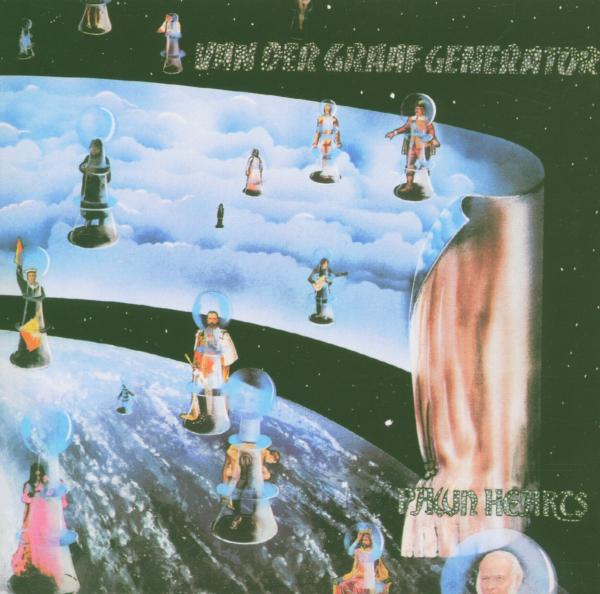Yuriy P. - 10/Jun/2025  Van Der Graaf Generator is a group that is incomprehensible even for progressive rock, since radical decisions are obvious (including a clear break with the tradition of classical music). This album is a fascinating journey into the secret world of this group, where everything is subject to completely different laws than the generally accepted ones. The atmosphere is extraordinary. However, it is worth noting that achieving this for the grandees of art rock is a piece of cake. The music itself is sometimes harsh and unusual, and sometimes very beautiful and lyrical (the rhyme just woke up). I would define the specific style of Generator as something between King Crimson and Pink Floyd. I cited the latter here as the standard of psychedelia, and in "Pawn Hearts" such trends are undoubtedly present. The bright and unique vocals of Peter Hammill and the omnipresent saxophone of David Jackson are the invariable attributes of Van Der Graaf Generator's style. Wait, it would be a crime not to mention multi-instrumentalist Hugh Banton and not to mention the brilliant drumming of Guy Evans (I hardly hear Fripp from King Crimson here). I will try to outline the contents of the disc somehow. 1) The first composition - "Lemmings" - immediately sets the tone for the fact that this is not a sunny and bright album, but the quintessence of dark-progressive with the corresponding mood and schizophrenic elements illustrating the crazy lyrics. From the very first seconds, when we first hear Hammill's voice, you can understand that this man is not just an ordinary vocalist; he lives what he sings about. The lyrics of the song are extremely apocalyptic; Hammill paints a very dark picture of the world and asks himself: what else is left but to die? However, by the end there is a noticeable enlightenment: it is still worth living and trying to save yourself. The main theme of this composition in combination with the vocals reminded me of the psychedelic-fairytale motives of Pink Floyd's music of the Barrett period (of course, Barrett himself was an apathetic vocalist, which cannot be said about the central voice of VDGG). The saxophone sounds in a cosmic style, after a short psychedelic shake-up we are presented with another strange melody, in which the role of the first violin is again played by the saxophone (intentional pun). Somewhere in this area you can also hear chaotic playing on the piano. Then we are offered the first musical theme again. No, no, all this is wonderful to listen to and does not tire at all! The end of this 11.5-minute composition is marked by an amazingly high-quality psychedelic atmosphere - here the group is in no way inferior to the luminaries of the genre.
2) The second piece "Man-Erg" begins very calmly, but soon Hammill's words are heard; he sings that there is a killer hiding inside him, and this, naturally, cannot but be reflected in the music: it literally wakes up to convey the state of the lyrical hero with maximum accuracy. Everything is relatively calm until the end of the 2nd minute, when we are overtaken by sharp sounds of the saxophone, and a harsh avant-garde instrumental part begins, which gradually slows down to ultra-low speeds. The words of the song in this part reflect the mental instability of the lyrical hero (to put it mildly - Hammill shouts: “How can I be free? Who will help me? Is it really me? Or is it someone else?"). Then again very calm music sounds with Hammill's quiet vocals, soon Jackson's delightful saxophone wakes up. In the vocal part that follows, Hammill's voice is even more emotional. At the very end of the composition, that same avant-garde nightmare that we heard before returns, but everything ends well. 3) “A Plague of Lighthouse Keepers” (“Eyewitness”; “Pictures/Lighthouse”; “Eyewitness”; ‘S.H.M’.”; “The Presence of the Night”; “Kosmos Tours”; “(Custard's) Last Stand’; “The Clot Thickens”; “Land's End (Sineline); “We Go Now”). This is a very dark, melancholic composition of classical duration (23 min.) with a bizarre combination of various musical themes. The music is basically meditative (which is supported by the organ and saxophone), but at times it takes on a heroic mood. However, in my opinion, the most brilliant moments of this opus are the marching fragments with absolutely crazy energy. You can expect eclecticism from Van Der Graaf Generator: their musical ideas are original and unpredictable (you can even hear ska rhythms). There is so much in this song that you need to listen to it, probably about 2 dozen times, to freely navigate its space. About the lyrical basis of this composition, see above - everything has already been told before us. I will only say that “A Plague of Lighthouse Keepers”, despite its monumentality, is already half a rock opera.
Separately, it is necessary to note the lyrics (they are worthy of being read) and the cover (it is worthy of being seen).
This album is integral, but not easy to perceive, but it is worth spending time on it (in attempts to clarify the phenomenon of Van Der Graaf Generator within the framework of art rock). In general, there are 2 possible states for its perception - contemplation and comprehension (the review is written to a greater extent in the first one). A masterpiece of inadequate
|



![Van Der Graaf Generator - World Record - 2CD + Blu Ray Remastered Box Set [US-Version, Regio 1/A]](https://img.grooves.land/images/cover/964/948/f6bwvrw7.j11)

![Van Der Graaf Generator - Live At Rockpalast-Leverkusen 2005 [DE-Version, Regio 2/B]](https://img.grooves.land/images/cover/100/908/tufjuh31.j11)
![Van Der Graaf Generator - Interference Patterns [US-Version, Regio 1/A]](https://img.grooves.land/images/cover/109/948/f6bwvr3a.j11)



























